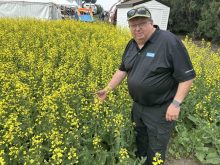A Saskatoon inventor has a new product to address spray drift problems for farmers looking for optimal grassy weed control.
While low-drift agricultural spray technology has improved dramatically over the past five years, it still hasn’t conquered the problem presented by grassy weeds.
Low-drift spray systems produce large spray droplets, but the droplets either slide off the slick surfaces of grassy weeds’ long vertical leaves or miss the sparsely placed targets altogether.
“These are tough targets and can be a real challenge for reduced drift technology,” said Wilf Wilger, of Wilger Industries in Saskatoon.
Read Also

First annual Ag in Motion Junior Cattle Show kicks off with a bang
Ag in Motion 2025 had its first annual junior cattle show on July 15. The show hosted more than 20…
Air induction nozzles, also known as venturi types, draw air into the body of the nozzle, causing turbulence. This turbulence reduces fine spray particles and produces large droplets while avoiding large fan-like spray patterns called laminar flow.
Venturi designs have their limitations when pull-type sprayers travel at lower speeds, or when lower water volumes are used for such things as spring spraying of contact products like glyphosate.
Wilger may have the answer.
With an American partner, he has developed a non-air induction nozzle that produces a coarse, large-droplet spray that will not easily drift, but still has many of the characteristics of the air induction nozzle.
The new design has an internal turbulence chamber that creates a pressure differential between the boom and tip. One orifice meters liquid flow and another creates a spray pattern.
The new Wilger Combo-Jet DR satisfies many of the needs of zero-tillage producers who operate sprayers at slower speeds, apply low water-to-herbicide ratio mixes at higher pressures, and want drift control.
Wilger’s nozzle is able to provide these rates because it can accommodate a 0.10-gallon-per-minute flow rate tip. It also eliminates the tiny air intake orifices that can become plugged.
The nozzle has an 80-degree spray pattern that is less likely to be caught by wind.
When equipped with a 0.3 GPM and smaller tip, it has a filter that is 40 percent larger than average. When equipped with 0.4 GPM and larger tips, it has an average size filter because the filter barrel is extended to create a larger turbulence chamber.
The new product has caught on with pull-type sprayer manufacturers. Many sprayers rolling out of Saskatchewan factories this year bear the new Combo-Jet DRs. The new design is available for Combo-Jet spray systems.
“There is no single solution for any farm or farmer,” said Tom Wolf, a research scientist with Agriculture Canada’s research centre in Saskatoon.
“If you use only one type of nozzle or another, there are going to be compromises.”
Wilger agreed.
He warns producers that while his product reduces the tiniest droplets, they are the most effective way to control weeds, especially grassy weeds.
Wolf recommends worrying more about weed control than drift control when choosing a nozzle.
“If you are spraying in conditions where it is necessary to control drift, without wind guards or other methods of drift reduction, then (reduced drift) nozzles are the way to go,” he said.
“When you get the chance to use something that gets the maximum amount of spray on the leaves of your target weeds, then that will be the thing to do.”
Farmers who use only one type of nozzle are encouraged by researchers to operate the reduced drift design, air induction or not, at higher pressures of between 60 and 120 pounds per square inch. This will improve spray patterns, reduce laminar flow and generate smaller droplets.
“You can’t start cutting your (herbicide) rates, water volumes or wait too long in weed staging, especially if growing conditions are less than ideal,” Wolf said.
“The coarse sprays produced by reduced drift technologies are not forgiving of shortcuts.”
















